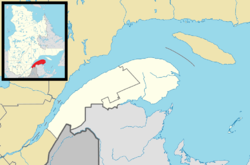Cacouna | |
|---|---|
 Cacouna Village seen from chemin des Pionniers in Riviere-du-Loup | |
 Location within Rivière-du-Loup RCM | |
| Coordinates: 47°55′N 69°30′W / 47.917°N 69.500°W[1] | |
| Country | Canada |
| Province | Quebec |
| Region | Bas-Saint-Laurent |
| RCM | Rivière-du-Loup |
| Constituted | March 22, 2006 |
| Government | |
| • Mayor | Suzanne Rhéaume |
| • Federal riding | Montmagny—L'Islet—Kamouraska—Rivière-du-Loup |
| • Prov. riding | Rivière-du-Loup-Témiscouata |
| Area | |
| • Total | 173.70 km2 (67.07 sq mi) |
| • Land | 62.75 km2 (24.23 sq mi) |
| Population | |
| • Total | 1,848 |
| • Density | 29.4/km2 (76/sq mi) |
| • Pop 2016–2021 | |
| • Dwellings | 954 |
| Time zone | UTC−5 (EST) |
| • Summer (DST) | UTC−4 (EDT) |
| Postal code(s) | |
| Area code(s) | 418 and 581 |
| Highways | |
| Website | www |
Cacouna (French pronunciation: [kakuna]) is a municipality[2] in the Rivière-du-Loup Regional County Municipality within the Bas-Saint-Laurent region of Quebec. It is located on the south shore of the Saint Lawrence River along Route 132.
The municipality of Cacouna was created in March 2006 through the amalgamation of the municipality of Saint-Georges-de-Cacouna and the parish of Saint-Georges-de-Cacouna.[4]
With a population of 1900, Cacouna is noted for the quality and unique architectural heritage of its buildings and for the richness and diversity of its agricultural life. The deep water port of Gros-Cacouna is a vital asset in the region's future development. Cacouna is a member of the association The Most Beautiful Villages in Quebec.[5]
'Cacouna' is also the name of an Indian reserve of the Quebec Maliseet Nation, more specifically Wolastoqiyik Wahsipekuk (Viger) First Nation, located in the administrative region of Bas-Saint-Laurent.

Many see in the name 'Cacouna' Cree words, kakwa or kakoua, meaning porcupine or dwelling or dwelling place of porcupine.[4] The actual location of Cacouna, however, puts this interpretation in doubt as the Cree have never visited this region. The Montagnais could have given the area its name during one of their crossings of the Saint Lawrence River in the past, as the word kaku also means porcupine in their language. More likely, though, the name could have come from the Maliseet word kakona. The name 'Saint George' was retained by Bishop Plessis in 1809 at the request of Malcolm Fraser, lord of Murray Bay (La Malbaie) from 1733 to 1815. Saint George, an officer martyred in Palestine in 303 AD, is a patron of the English people and his battle against the dragon has been represented multiple times in art.
- ^ Cite error: The named reference
toponymiewas invoked but never defined (see the help page). - ^ a b c "Répertoire des municipalités: Geographic code 12057". www.mamh.gouv.qc.ca (in French). Ministère des Affaires municipales et de l'Habitation.
- ^ a b Cite error: The named reference
cp2021was invoked but never defined (see the help page). - ^ a b "Cacouna – Une riche histoire". Archived from the original on 2018-08-12. Retrieved 2019-04-11.
- ^ "Association des plus beaux villages du Québec – Cacouna". Archived from the original on 2015-06-23. Retrieved 2015-06-14.
